Editor's note: There are national park trips, and then there are national park trips. Trips that require a good amount of planning, expense, and travel. These are parks that not only might you visit just once, but which you experience in a truly unique way. These are parks that definitely fall under the "Trip of a Lifetime" category. This occasional series, which kicks off with a week-long exploration of Glacier Bay National Park and Preserve, introduces you to one of those trips.
As our kayaks bob on the currents of Fingers Bay, a multi-fingered bight in Glacier Bay, we listen for the tell-tale streaming whoosh of a humpback whale's spout. We had seen the wispy spray moments earlier as we neared the mouth of the small bay and watched as the whale circled, its occasional spouting marking its progress.
With the weather closing in, ashy grays muting the green hues of the Sitka spruce forests that descend the mountains' flanks out of the clouds, we wait. Foggy tendrils crawl through the forest down to the water, merging landscape and seascape. Far across the water rafts of teal -- green-winged and possibly cinnamon -- cruise the shoreline. Around us harbor porpoises -- nature's truly synchronized swimmers -- circle, rolling their backs in unison above the bay's surface. Out near the mouth of the small bay, curious harbor seals eyed us.
When last seen, the whale was far behind us, near the bay's mouth. Just when we figure the humpback had headed into the deeper waters of Glacier Bay proper, it surfaces barely 20 feet off our bows, startling us and delighting us all at the same time.
This truly is an adventure, something a guidebook or brochure can't predict or guarantee. And it all is a private showing to our small group. The 10 of us had come from different corners of the country -- from Utah, Massachusetts, and Connecticut -- to experience not just the ice rivers of Glacier Bay, but its lush rain forests, and its marine environment that, as we discovered, literally erupts with life.
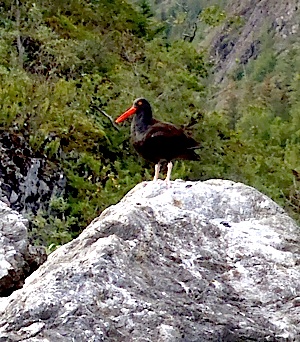
We became well-familiar with Black oystercatchers during our exploration of Glacier Bay National Park and Preserve. Marcelle Shoop photo.
Perhaps what we didn't expect was that the week-long tour would encompass lessons not only in marine biology, geology, and successional ecology, but doses of history as well in a circle of growing camaraderie.
In Search Of Glacier Bay
Simply reaching the park is an adventure as you link airports together at odd hours of the day. And planning to spend six days aboard the Sea Wolf, a converted World War II minesweeper, while exploring the park's interior takes some planning, as well. Spanning more than 3.2 million acres but with fewer than a dozen miles of road, Glacier Bay is not an easy park to explore if you really want to savor what it offers.
Most visitors head to Gustavus and the Glacier Bay Lodge, where they typically spend two or three days. It's time usually spent looking at Bartlett Cove, hiking a trail or two, and taking a day cruise to enjoy the park's wildlife and glaciers before heading somewhere else.
To go beyond that first-blush introduction, you must leave Gustavus behind and venture deeper into the park. For the experienced and the hardy, that might entail setting off on a self-organized or outfitted kayak trip deep into the bay. For the truly adventurous and self-reliant, such as Andrew Skurka, a pack on the back, good hiking boots, and accurate maps are enough to venture into the backcountry.
While massive cruise ships also head deep into the park, the discriminating explorer of national parks might be enticed by a smaller, more sophisticated and intimate approach aboard one of the small-ship operations that offer multi-day voyages into Glacier Bay.
Trying to pick one without a recommendation can be like trying to win the lottery. In these days of social media buzz, we had stumbled upon Sea Wolf Adventures on Twitter. A quick check of their website, and a phone call or two, convinced us to throw our lot with Sea Wolf owner and captain Kimber Owen and her crew. By the end of our week on the water, we felt as if we had won the lottery.
Living History Under Foot
At 97 feet long with racks of sea kayaks on her top deck, the Sea Wolf is a mothership that comfortably handles a dozen passengers, plus a crew of five or six. With sleek lines, warm-hued planking, six cabins, and comfortable common areas, she keeps her history well-hidden.

The Sea Wolf started out as a World War II minesweeper, the USS Observer.
But that history is almost as entrancing as the Glacier Bay landscape she cruises. Appearances can indeed be deceiving, for the Sea Wolf got her start in the Fulton Shipyard in California in 1941 when she was known as the USS Observer and went to sea for the U.S. Navy as a minesweeper.
While she outwardly has changed quite a bit since those days, the ship still throbs with her original Hamilton diesel engines. Gone, though, are the 50-caliber machine guns once mounted fore and aft, as well as the turret gun that sat amidships. Still intact, though, are timbers of solid oak upwards of 31 inches in diameter that went into the hull.
The ship had gone through several iterations before it came to Ms. Owen in 2003. When it entered World War II, it was black, and lacked a covered salon (akin to a living room in your home). After the war, when most of her sister ships were buried at sea, she was turned into a private yacht in the 1950s, and a decade later was acquired by an oil company. In the 1980s another charter company bought the ship and used it to help promote protection for the Tongass National Forest.
Today Sea Wolf bears slight resemblance to the AMc91 minesweeper.
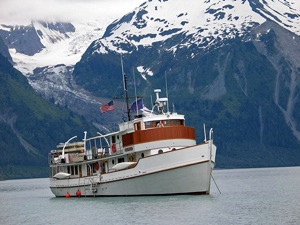
The Sea Wolf today. Sea Wolf Adventures photo.
The aft is fully enclosed and heated for dining or to provide shelter from the weather when you're under way, and of course there's the salon with its couches, reading materials, and shelves stacked with binoculars. (Too, Ms. Owen, made the ship fully wheelchair-accessible. Passageways are wide enough to accommodate wheelchairs, there are lifts to all decks, and wheelchair-accessible cabins and public areas, and a system for lowering handicapped passengers into kayaks. Last year the National Park Service honored Ms. Owen for her efforts with its National Accessibility Achievement Award.)
Spending six days aboard the ship—with daily kayaking and hiking excursions that allow you to experience the park— indeed is a trip of a lifetime.
Going To Sea
But before you can explore, you have to outfit yourself for a week of paddling and hiking. This entails obvious items -- good rain gear from head to toes to stand up to Alaska's often-wet weather; baselayers that not only can be added and subtracted as needed, but which dry quickly, and; with an eye toward storage, a wardrobe that doesn't require hanging or ironing.
For Lower 48ers, the list includes some decidedly unusual items. In Alaska's coastal southeastern tip, rubber boots are ubiquitous. Knee-high and durable, you wear these boots to go ashore, to walk through the rain forests, to keep your feet warm and dry. And since Ms. Owen leads you ashore to explore boggy rain forests and confront a glacier face-to-snout, these boots almost immediately are your most prized possessions.
True, it takes a little practice to insert your boot-encased feet into a kayak, and a great sense of balance to get in and then back out of your kayak after shore leave without taking a plunge, but you learn quickly.
Getting comfortable on the Sea Wolf doesn't take long. Though it hulks over the Park Service dock on Bartlett Cove in Gustavus, the ship quickly, and comfortably, becomes home.
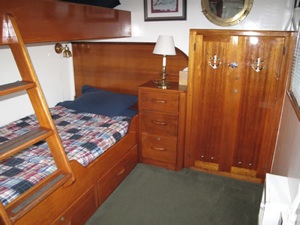
Staterooms are small, but charming. Sea Wolf Adventures photo.
True, the cabins are, shall we say, cozy, with bunk beds, tiny sink, and toilet space integrated into shower space. But after whacking the head a few times on the upper berth, and working on dance moves with my wife as we swapped positions while dressing and undressing, the accomodations really do add great atmosphere to the trip.
Just aft of our cabin is the salon, a perfect place to relax with a cup of coffee or tea before the day gets started, or with a glass of wine or bottle of beer as it winds down. Conversations swirl about the day's explorations and discoveries: Coastal brown bear scat on the beach, bald eagles perched in trees or flying overhead, whale bones washed ashore, sea otters on their backs watching you, sweet and succulent patches of wild strawberries the bears somehow overlooked.
And if you have any questions about these discoveries, or simply want to learn more, the salon has endless books and magazines about Glacier Bay, its geology, waters, marinelife, birdlife, and mammals.
The Sibley Guide to Bird Life and Behavior, An Uncommon Field Guide to Northwest Mountains, Geology of Southeast Alaska Rock and Ice in Motion, The Birder's Handbook, A Field Guide to the Natural History of North American Birds, the National Audubon Society Guide to Marine Mammals of the Word, and even The National Parks, America's Best Idea by Dayton Duncan stand ready to sate your curiosity.
While the crew was readying the ship for sea, we were briefed on safety precautions -- where to go in case of a fire, where survival suits and life preservers were stowed, the redundancies of all the systems on board, how to rescue anyone who fell overboard, how to be rescued, the commands the crew would be giving us.
After that, we were told the trip would be akin to a time-lapse photography exhibit of the landscape. Glacier Bay, Ms. Owen explained, is an evolving landscape as glaciers, with few exceptions, continue their slow retreat.
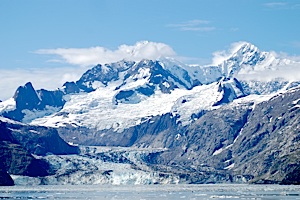
When the clouds lift and the sun comes out, the park's landscape -- this is the Johns Hopkins Glacier -- is riveting. Kurt Repanshek photo.
During the week we would pass through a succession of landscapes, from the head of Glacier Bay where glaciers have scraped the rock bare of soils and vegetation, down to lush rain forests that have reclaimed lands near Bartlett Cove that were tilled by glaciers as recently as 1800.
"It's one of the few places in the world where you can see geology and the resulting flora and fauna succession in motion, because everywhere else it's already happened," Ms. Owen tells us.
What that landscape might reveal in terms of wildlife is hard to predict. Glacier Bay National Park and Preserve is home to three or four wolf packs, a few wolverines, Brown bears, black bears, mountain goats, and a birder's life list of feathered creatures, big and small. But predicting when any of those creatures might appear is impossible.
Also hard to know is when whales -- Humpback, Minke, and killer whales all have been sighted in the park's waters -- might surface. Harbor seals and sea otters, however, are frequently spotted, and birds seem to be everywhere -- overhead, on the water, in the trees.
As we prepared to set out on the water for the first time, Ms. Owen told us, "This is the time to acclimatize yourself, getting your eyes accustomed to the perspective."
"We'll see all kinds of rocks. Moose rocks, bear rocks," she went on, an apparent reference to our over-anxiousness to see wildlife.
"Reid (Glacier) is one of our smaller glaciers, but it's a friendly glacier. We can walk right up to it and look for ice worms. We'll look at the dynamics of a glacier, how it's carved out the landscape."
Cruising slowly up the 65-mile length of Glacier Bay, she told us, could reveal a wealth of wildlife.
"Sometime you see whales and orcas in there. You never know what you're going to see. It's such an amazing place," Ms. Owen said.
And once we leave the Sea Wolf in our two-person sea kayaks, we'll confront the park pretty much eye-to-eye: "We'll immerse ourselves into the park-becoming a part of the landscape. The beauty of paddling in the wilderness is you're on eye level with the fauna of the land and sea, a very different perspective than from being on the decks of a ship," she said.
On the Water
Squeezing into a sea kayak while on the water is an acquired skill, particularly when you're wearing rain gear head-to-toe, your mandatory rubber boots, spray skirt, and life preserver.
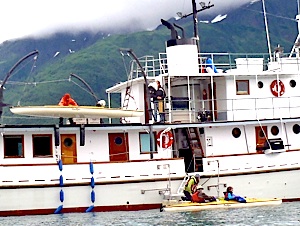
A floating platform made it easy to get in and out of the kayaks. Kurt Repanshek photo.
But with the crew's help we soon became adept at sliding off a large square raft lowered into the water for entering and exiting the kayaks.
As the week progresses, we head north, leaving Bartlett Cove for Shag Cove and Reid Glacier, then an anchorage near Marjorie Glacier, on to Russell Island and another anchorage from which we spot a brown bear fishing on shore, then to Gloomy Knob and an anchorage near Seabree Island, then to Fingers Bay for another night and up into Dundas Bay. Each day offers ample opportunities to paddle or venture ashore to explore the land under our feet.
During our paddle to Marjorie Glacier, one of the park's seven tidewater glaciers that run right down to the fjord waters, Ms. Owen leads us single-file through a bobbing ice field while maintaining a running account of seabirds that cross the skies overhead, pause to rest on one of the bergs, or land on a cliff-side perch.
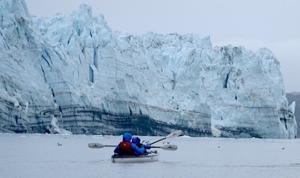
Padding to Marjorie Glacier. Marcelle Shoop photo.
En route to the glacier we pass a massive cliff alive not only with birds, but with water -- rivulets, torrents leaping and frothing, plunging from icemelt down to the sea.
Drifting with the tide in front of Marjorie Glacier from a safe distance, we watch as it calves, seeing the fracturing ice a second before thundering cracks and snaps of shearing ice and its accumulated debris reach our ears.
On another day we paddle past Black oystercatchers atop a rocky outcrop guarding the mouth of Tidal Inlet, their bright yellow eyes peering from their coal-black plumage giving us the once over, their carrot-like beaks removing them of any sternness. Deep in the inlet we encounter rafts of hundreds, perhaps even thousands, of black scoters stretching across the water. With their black bodies, and bright yellow-orange bills, Ms. Owen calls them the "poor man's puffin."
By week's end our checklist of birds overflows. There have been the real puffins, both Tufted and Horned, Murrelets (mostly Marbled, but a few Kittlitz's and Ancients), Glaucous and Mew gulls, Black-Legged Kittiwakes, Arctic Terns, Pacific and Common Loons, Bonapart gulls, Bald Eagles, Pelagic, Brandt, and Double-crested Cormorants, Pigeon Guillemots, Common Murres, Great Blue Heron, Brandt and CanadaGeese, Barrows Goldeneye, Harlequin Ducks, Spotted Sandpiper, Least Sandpiper, Smei-Palmated Plovers, Varied, Hermit and Swainson's Thrushes just to name the short list of common sightings.
Travel to Glacier Bay National Park and Preserve via our slideshow
Ms. Owen also regales us with the vegetation we walk through, vegetation that speaks to the various landscapes through which we pass (muskeg, the beginning colonization of the forest, and the mature forest): bog blueberries and cranberries, bunch berry, bane berry, spaghnm moss, Goat's bear, broadleafed sundew, Marsh marigolds, Club Moss, Devil's Club, lichens and moss, fireweed, willows, alder thickets, Sitka spruce, hemlock, winter greens, twisted stalk, False hellebore, False lily of the valley, Trailing Club Moss, Shelf fungus.
Of course, all the fresh air, all the paddling and hiking, requires calories and protein to keep you going, and the Sea Wolf doesn't disappoint its guests there, either. Angelica Lenning, trained at the Ballymaloe Cookery School in Cork, Ireland, kept us well-fed throughout the trip. At times she literally dipped into the sea for dinner, steaming a cauldron of Dungeness crab one night, and broiling some salmon the next.
Near the head of Dundas Bay, home to the largest tidal ebb in southeast Alaska, the mountains wrap us, blinding the ship to radio signals and even satellite reception. Low clouds cloak the rain forest, but the drab is brightly off-set by red baneberry, a highly poisonous plant. Shelf fungus sprouts from treen trunks, catching droplets of rain, and up some of the side canyons there even are patches of snow despite the late August day.
After our hike, we paddle across the bay and into Dundas River, which really isn't much larger than a creek.
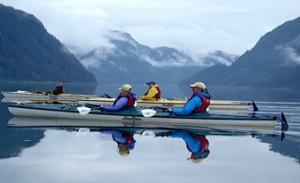
Dundas Bay graced us with glassy waters and towering mountains. Kurt Repanshek photo.
Partially consumed salmon carcasses litter the streambed below, the work of bears that crashed down into the stream to catch their fishy meals.
After beaching our boats we walk along the stream. My eyes nervously flick back and forth across the shores and into alder thickets, searching for bears, my ears straining to pick up any sound not tied to the winds, creaking trees, the rolling stream, or birds.
In this tiny interface where a rivulet from the vast interior feeds an equally, even unimaginably, vast entrance to the sea, the immensity of this natural world—and our experience of it—seems suddenly graspable. No longer simply another name among the 397 in the National Park System and a farflung dot on the map, Glacier Bay has come to life. Though we might never get back, it's been an adventure we'll never forget, one that showcased, even if only for a week, a trip of a lifetime.




 Support Essential Coverage of Essential Places
Support Essential Coverage of Essential Places







Comments
How incredibly exciting!!
This is a lovely write-up. A readers gets the sense of the wonder of the place. It is a trip of a lifetime and there is so much learning taking place at the same time.
What is a glacier worm?
I found this on them - "it is not known how ice worms tunnel through the ice. Some scientists believe they travel through microscopic fissures in ice sheets, while others believe they secrete some chemical which can melt ice by lowering its freezing point, like anantifreeze. They feed on snow algae". (They melt in the sun!)
I am so thrilled to know the Sea Wolf/Observer is still sailing! I toured the Tongass National Forest on her in the 1980s, when she was operated by "another charter company" and still known as the Observer. Thank you very much for the pictures, which brought back great memories. She's a great ship, and a wonderful way to see Alaska waters.
Loved the story!! Definitely a trip to think about if I ever get back to Alaska.